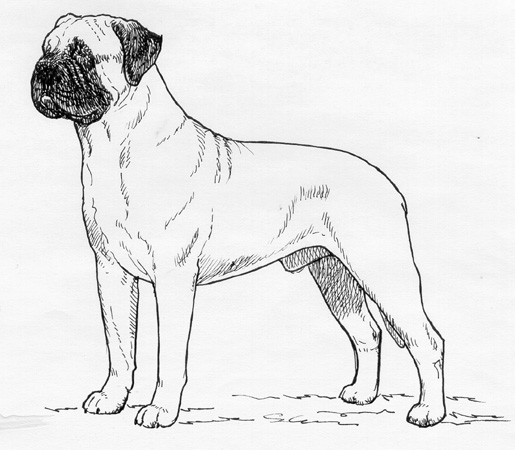Bullmastiff
Guardian Dog Group
The goals and purposes of this breed standard include: to furnish guidelines for breeders who wish to maintain the quality of their breed and to improve it; to advance this breed to a state of similarity throughout the world; and to act as a guide for judges.
Breeders and judges have the responsibility to avoid any conditions or exaggerations that are detrimental to the health, welfare, essence and soundness of this breed, and must take the responsibility to see that these are not perpetuated.
Any departure from the following should be considered a fault, and the seriousness with which the fault should be regarded should be in exact proportion to its degree and its effect upon the health and welfare of the dog and on the dog’s ability to perform its traditional work.
History
In its present form, this is a fairly new breed, developed about 1860. The purpose for the development of the breed (a 60% Mastiff, 40% Bulldog cross), was to stop poaching in the English estates. The landowners wanted the poachers thrown and held but not mauled. The Mastiff, while powerful and courageous, was not fast enough and sufficiently aggressive. The Bulldog was a little too ferocious and not large enough for the task. This cross resulted in the development of a breed that was totally utilitarian.
The Bullmastiff was recognized by the United Kennel Club in 1948.
General Appearance
The Bullmastiff is symmetrical in structure. The breed is powerfully built, showing great strength and endurance, and is active. It is alert and fearless, yet docile in manner. It may be red, fawn or brindle in color, with a natural tail and ears.
Characteristics
High spirited, alert and reliable, the Bullmastiff is a dependable family companion and protector.
Head
The head is broad with well-developed cheeks and a fair amount of wrinkles showing when the dog is alert.
SKULL
The skull is large and square; the circumference of the skull may be equal to the height of the dog at the shoulder. The stop is pronounced.
MUZZLE
The muzzle is short, blunt and squared off. It is approximately one-third of the length of the entire head. The flews are not pendulous. A dark muzzle is preferred.
Serious Faults: Lack of foreface, with the nostrils set on top of the muzzle such as in the Bulldog.
TEETH
A full complement of large, strong, white teeth meet in a level or slightly undershot bite. The canine teeth are large and set wide apart.
NOSE
The nose is black. The nostrils are large and broad.
EYES
The eyes are dark and of medium size. They are set well apart, and there is a furrow between them.
Serious Faults: Light or yellow eyes.
EARS
The medium-sized, V-shaped ears are set wide and high on the skull, level with occiput and close to the cheeks, giving a squared-off appearance to the skull.
Serious Fault: Rose ears.
Neck
The slightly-arched, muscular neck is of moderate length; it has almost the same circumference as the skull.
Forequarters
The shoulders are muscular, sloping, and powerful, but not loaded.
FORELEGS
The powerful, straight, well boned forelegs are set wide apart, showing a straight front. The pasterns are straight and strong.
Body
In proportion, the Bullmastiff is just slightly longer, from the breastbone to the buttocks, than he is tall, resulting in a fairly square appearance. The chest is wide and deep, and well let down between the forelegs. The back is short and straight, giving a compact carriage. The loin is wide and has good depth.
Faults: Roached back; sway back.
Hindquarters
HIND LEGS
The hind legs are strong and muscular, with a well-developed second thigh. When viewed from the rear, they are parallel. The hocks are moderately bent.
Serious Fault: Cow hocks.
Feet
The feet are medium-sized, with well-arched, rounded toes. The pads are thick and tough. Dark toenails are desirable.
Serious Fault: Splayed feet.
Tail
The tail is set high, and is carried straight or curved. It is strong at the root, and tapers, reaching to the hocks.
Coat
The coat is short and dense, and lies flat to the body, giving protection to the weather.
Color
Any shade of brindle, fawn or red; to be pure and clean. A slight white marking on the chest is permissible. A dark muzzle is essential. The ears are darker than the body.
Disqualification: Albinism.
Height & Weight
Males: 25 to 27 inches at the shoulders, and from 110 to 130 pounds.
Females: 24 to 26 inches at the shoulders, and from 100 to 120 pounds. Size is proportionate to weight, with the heavier dog being preferred.
Gait
Free and powerful, indicating a sense of purpose. Legs do not cross or interfere and the back remains firm and level.
Disqualifications
(A dog with a Disqualification must not be considered for placement in a conformation event, and must be reported to UKC.)
Unilateral or bilateral cryptorchid.
Viciousness or extreme shyness.
Albinism.

Looking for a Dog?
Find a dog that will fit your family.
Note: The breeders on this list are not endorsed by UKC.
Revised March 1, 2008
©Copyright 1991, United Kennel Club
